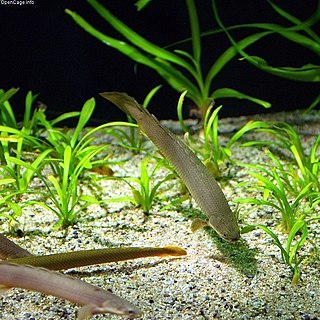
Hypostomus is a genus of catfish in the family Loricariidae. They are native to tropical and subtropical South America. H. plecostomus is the popular freshwater aquarium fish formerly known as Plecostomus plecostomus. The taxonomic structure of the Loricariidae is still being expanded by scientists. Hypostomus is a highly species-rich and widely distributed catfish genus.

Agathidium is a genus of beetles in the family Leiodidae.
Georg Wolfgang Franz Panzer was a German botanist and entomologist.

The Lonchopteridae are a family of small (2–5 mm), slender, yellow to brownish-black Diptera, occurring all over the world. Their common name refers to their pointed wings, which have a distinct venation. Many are parthenogenic; males are very rare, however, at least in North American species, and have a somewhat different venation than do the females.

Python is a genus of constricting snakes in the Pythonidae family native to the tropics and subtropics of the Eastern Hemisphere.

The Boridae are a small family of tenebrionoid beetles with no vernacular common name, though recent authors have coined the name conifer bark beetles. The family contains three genera. Boros is native to North America and northern Eurasia, Lecontia is endemic to North America, while Synercticus is found in Australia and New Guinea. The larvae of Boros are found under bark and are especially associated with standing dead trees (snags), typically pines, found in old-growth forests. Lecontia larvae are found inhabiting damp parts of the root system of dead standing trees. Little is known of the life habits of Synercticus.

Bembix is a large cosmopolitan genus of large, often brightly colored predatory sand wasps, consisting of about 380 species.
Agathidium vaderi is a species of round fungus beetle in the family Leiodidae. It is found in North America. The beetle was named after the fictional character Darth Vader by Cornell University entomologists due to its shiny helmetlike head that resembles that of the Star Wars villain.

Nowickia is a subgenus of large flies in the family Tachinidae.

Endomychidae, or handsome fungus beetles, is a family of beetles with representatives found in all biogeographic realms. There are around 120 genera and 1300 species. The family was established based on the type genus Endomychus, a genus erected in 1795 by Panzer which was applied to a species that Linnaeus called Chrysomela coccinea. As the common name suggests, Endomychidae feed on fungi. Crowson, in his influential treatment of the beetles, placed the family within the Cucujoidea. They have a tarsal formal of 4-4-4 or 3-3-3 and the wings lack a closed radial cell. The second antennal segment has a sensory appendage that is as long as the third antennal segment. The family has also been grouped with the Coccinellidae in a group called the Trimera for having pseudotrimerous tarsi. A 2015 molecular phylogeny study found that the Cucujoidea were found to be non-monophyletic and the Endomychidae was refined with the removal of the Anamorphinae from within the family and elevated to the status of a full family, Anamorphidae. Mycetaeinae and Eupsilobiinae were also found not to belong within the clades of the core Endomychidae, and likewise reclassified into the families Mycetaeidae and Eupsilobiidae.

Gymnosoma is a genus of flies in the family Tachinidae.

Alexiidae is a family of beetles. It contains a single genus, Sphaerosoma, formerly included within the family Cerylonidae, with around 50 species which are native to the western Palearctic. Species of Sphaerosoma are very small, around 1 to 2 mm in length rounded beetles with clubbed antennae. They are fungivores, having been observed feeding on mushrooms, and have also been found in leaf litter and on decaying bark.

Cladistia is a clade of bony fishes whose only living members are the bichirs of tropical Africa. Their major synapomorphies are a heterocercal tail in which the dorsal fin has independent rays, and a posteriorly elongated parasphenoid.

Sulcacis is a genus of tree-fungus beetles in the family Ciidae.

Thyreophora cynophila, commonly known as the bone skipper is a species of fly native to Europe. It was once thought to be the first fly to be driven to extinction by humans, but rediscovered in 2009. It has a bright orange head, and is associated with animal carcasses where the bones are broken open.

The Brachyopini is a tribe of hoverflies. Unlike many members of this family these flies are generally darker and less colourful though some genera contain species with an attractive metallic lustre e.g. Chrysogaster. Some like Brachyopa are associated with sap runs where their larvae feed on decaying sap. Others are found in boggy areas where their often semiaquatic larvae feed on decaying organic matter.

Rhynchophorus, or common name palm weevils, is a genus of beetles in the weevil family, Curculionidae. Palm weevils are major pests of various trees in the family Arecaceae throughout the tropics including: coconut, Areca catechu, species of the genus Phoenix, and Metroxylon sagu. Two species are invasive pests outside their native ranges, Rhynchophorus ferrugineus and Rhynchophorus palmarum.

Urophora stylata is a species of tephritid or fruit flies in the genus Urophora of the family Tephritidae. The host plant for the larvae is usually a thistle of genus Cirsium or Carduus.

Chamaemyia is a genus of flies in the family Chamaemyiidae. It is the type genus of its family.
Tyrus is a genus of ant-loving beetles in the family Staphylinidae. There are about five described species in Tyrus.

















